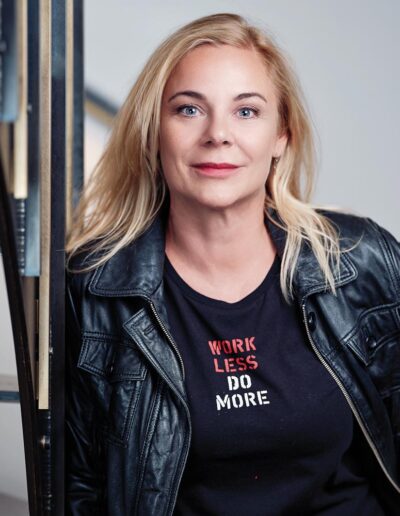AI does already solve a great number of problems, although we might not be aware of it. Defined by Turing in 1950, AI is simply defined as “the science and engineering of marking intelligent machines”. But AI is already commonplace in modern life for accessing information, and has been introduced in healthcare for purposes such as facilitating clinical ordering systems and identifying high-risk patients for screening tests as well as in marketing systems. If we take a closer look, AI is already almost everywhere.
Gracy Damasceno is Global Digital Solutions Head at Galderma in Lausanne, a Swiss pharmaceutical company specialising in dermatological treatments and skin care products. For years, Gracy has worked in a field that is all over the place: transformation and artificial intelligence. So, how can an organisation, a company transform in a clever way while using AI tools? How can AI really make our lives easier and better? And where is the difference between artificial intelligence – and wisdom? – We take a deep dive.
Ladies Drive: Gracy, you have worked with AI tools for many years, for instance as Digital Transformation Product Manager at IMD Lausanne or as Digital Programme Manager at Nestlé Nespresso and now at Galderma. Do you understand why a lot of people are worried about AI?
Gracy Damasceno: What is interesting about AI is that it’s not really “artifi- cial”. It’s a machine that we have to teach, how we want it. I do understand the worry but there are just a few misconceptions when people who are not familiar with it. Companies with ethical responsibility will choose use cases and leverage existing data, and possibly automate some activities. So that either would help people perform their tasks or completely automate it. That’s basic, but important. At Galderma we use AI for the chatbot on our website. Or to connect data – e-commerce and services for instance. When we connect data sources to different systems (including AI) – it allows for us to understand our customers better – and this helps us to interact with them in a personalised manner. That’s the advantage for us on the business side. As a customer, AI will help to make your shopping experience faster, so we don’t lose time in browsing back and forth on a website. That’s the power of it. It’s creating more meaningful interactions with the customers because you are using artificial intelligence to help us. So, AI can help us, on under- standing better what could be offered to our customers (products or services), what would be of interest to them. But we don’t let the artificial intelligence run its own course. We take advice from it, sometimes. And artificial intelligence is helping us be better at our jobs.
Before we continue our conversation on AI, how did you learn how to use it wisely? Can you share a little bit more about your career steps?
Sure! I am Brazilian and studied Business Management and Administration before I left. I moved to Belgium, later to France. Before I came to Switzer- land, I was also in Abu Dhabi and worked in the Formula One Grand Prix. While still in Brazil, my first job was for a tech company called Sun Microsys- tems. It was in 2000 and we had this amazing start up culture – and I learned a lot! In France I had my son, stayed two years before moving to Switzerland – and my first job here was in Nespresso – I worked for Nespresso in a big transformation programme. From Nespresso I moved to IMD and there I actually started my path with Salesforce, since it was a Salesforce transfor- mation/technology implementation. We completely changed the organisa- tion, the experience of the participants of the programmes and the students of the MBA courses. We took a lot of feedback and we learned from them, what they expected and how we would build the system so that it would better serve our customer. And that’s also how Galderma got interested in my background, since I had this Salesforce expertise. I know how Salesforce connects AI with our data and your CRM. And that’s also where I learnt about AI and generative AI. Galderma invested a lot technology wise – and I came in to be a bridge between tech and non-tech people. I talk with both groups and make it possible to implement something that can support the business and the customers, and help deliver business results.
We talk a lot about technology, artificial intelligence, but at the end it’s the people to create all that. Create and connect the dots.
Exactly. Yes, you must put people together. So now we’re doing an initiative in Galderma with where we put people together from different areas of the business, customers, everybody, we interview all these people, we do workshops together to extract knowledge and wisdom which is already in the company – but not yet brought to light. We let people talk to each other who usually never sit at the same table together. This results in many great ideas for the company!
So since you’re working with Galderma what could you transform, what could you change, what were the inputs that you brought to the table?
First you need to understand that everything is connected. If we look at our business from a holistic point of view, we will do our job much better. So that’s my approach. We need to see the full picture. And when I implement technology, even if the people are not talking to each other, I make sure I’m talking to all the relevant people, so that I implement something that makes sense for everybody and that will help the organisation and help the customers. So that’s for me the biggest value. We transform how people perceive technology in the company.
Can you share a little bit more about how you did help Galderma to trans- form?
Customers used to know a brand, now they know the company. We created this Galderma story and customers started to interact with us and now they know that Galderma is holistically looking at skin – we’re more than just “another brand”.
How did AI help you to get there…?
Well, first things first: there are different kinds of artificial intelligence, right. Nowadays people are talking a lot about Chat-GPT because it’sgenerative AI. So it’s creating content and searching information and creating a lot of things for you. In all these interactions artificial intelli- gence will tell us, based on all these interactions: this is the next thing that you could do with this customer. For instance: a lot of companies are just sending thousands and thousands of emails to their customers, all with the same content. With artificial intelligence we can not only create meaningful e-mails but tailor-made communication with your customer, even create a tailor-made customer journey that drives sales.
So AI helps to create personalised customer journeys…
Yes. It would be almost impossible to create personalisation without artifi- cial intelligence. We work with AI on Salesforce for instance. The AI suggests how we could proceed with a customer – but we always decide if we allow the system to do it or not, like let me send an email to a customer or not. Where to invest our marketing or paid media efforts, etc.
But what is the biggest challenge if you work with an artificial intelligence – just in general?
It’s the data strategy. Most companies have a lot of data, they don’t even know what data they have, and they don’t know where it’s sitting. To make artificial intelligence very meaningful, we must have a data strategy. Know your data. I have data, it’s here and how do I make it available for my artifi- cial intelligence? How do I make sure that this data is compliant with the rules or with data protection rules and regulations for instance? So it’s more around what data is available, how do I make it available, how do I make sure it’s compliant, that it’s secure, and do I want this data to be used this way? And it requires a lot of coordination between people. That’s why I talked about people so much. People have their own processes in their own areas. Because we are a pharmacy company, we interact a lot with doctors, nurses and medical professionals. But we have different departments that interact with them and produce content for them, on their own. So the question is: how do you bring all of this together to make it available if needed, at the right time? That’s the biggest challenge. It’s like a sea of information. I think that’s also the problem of Chat-GPT, because if you are looking on the internet for data, everything is there. Bad information, and good information – and you don’t want to make available non-compliant data for example. When you are doing this in a company, in a controlled environment, you have to make sure that all the data that you make avail- able is correct and compliant. This is often a painful process, because we need people who are held responsible for this data. Make sure the data is correct, reviewed, legally approved. It’s a heavy process before you can get to benefit from the power of AI.
What would you advise or what kind of tips and hints would you give to other business owners if they are willing to start with that process to work with an artificial intelligence now?
If you think you want to work with artificial intelligence, first know exactly what you want to do. Maybe you just want to use it for service or for marketing – it’s not just something that will solve all your problems. So, you have to be specific about it. Then you need to get highly skilled people. So, they will give you all the inputs that you need to be able to then start putting the data in the right places so you can leverage it.
You mentioned already that you work with Salesforce. Why did you pick it in the first place as a partner to do all that?
We could have chosen five different providers for the five different things we have with Salesforce today, but it makes it so much easier for us and it accelerates our transformation to have all of this with one technology partner, one ecosystem. And what I personally like about Salesforce is the flexibility. I worked in education and now I’m in the pharmacy business and it works well for any type of business.
The market changes very fast and at a very high pace and you need to kind of keep up. How does a provider like Salesforce help you to adapt new technologies quickly and in a sustainable way?
This technology shows us things that are possible that we didn’t even think about. Indeed, they do a lot of innovation for us. They are innovating all the time and we can accelerate our business thanks to it – for instance their Customer Data Platform. I know so much more about my customer because I can connect systems like a website, or social media channels – into our CDP. So I can connect and then it opens up so many more possibilities and I can do more personalisation, more segmentation with the customers. It’s a much better engagement.
So what drives you personally? What makes you get up in the morning with a smile on your face?
Human centricity. And I’m the least tech person of all the tech persons because what I care about is the human. You know if this tech can help the human, that’s what I’m passionate about. So, I look at the person, what their needs are, or the business, and our customer and think about how this technology can help everybody. For me, it’s about making people’s lives better. When you work with marketing technology, it still needs to be meaningful.
And if you need some wisdom from someone, do you ask your best friend? Do you read a book, or do you ask an artificial intelligence?
I might do the three (laughter).
What first?
First, I reflect, then I might talk to a friend. Then I might ask Chat-GPT.
We talked a lot about intelligence. But where do you turn to if you need wisdom?
To a true friend. A true human being.

















